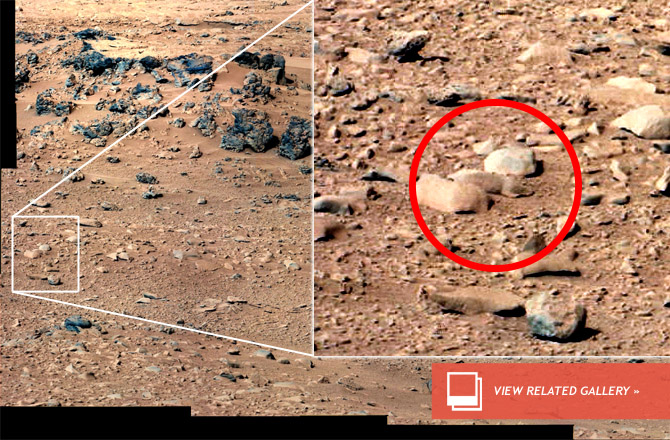
NASA's Mars rover Curiosity will apparently perform no follow-up studies of a Red Planet rock that resembles a rodent, dealing a blow to the nascent field of Martian mammalogy.
The so-called "Mars rat" has generated a lot of Internet interest lately, with some UFO buffs claiming that it may be an indigenous Red Planet lifeform or an Earth rodent Curiosity carried to Mars as part of a secret experiment.
But Curiosity scientists are pretty sure that the Mars rat — which was spotted in a zoomed-in portion of a photo taken by the rover in September 2012 — is just a rock. ['Mars Rat' Photographed by Curiosity Rover (Video)]
"Clearly, it results from, you know, a lot of things like wind erosion and mechanical abrasion and breakdown chemical weathering of the rocks, as to why they get these weird shapes," Curiosity deputy project scientist Joy Crisp, of NASA's Jet Propulsion Laboratory in Pasadena, Calif., told reporters Wednesday (June 5).
So there doesn't seem to be a lot of motivation among mission scientists to investigate the Mars rat further. And the window to do so will last just a few more weeks, as the Curiosity rover is set to begin an epic drive that will take it far away from the petrified rodent.
The 1-ton robot is gearing up to embark for the base of Mount Sharp, a mysterious mountain that rises 3.4 miles (5.5 kilometers) into the Red Planet sky. The trek will cover about 5 miles (8 km) of straight-line distance and will likely take about a year, mission managers said.
Curiosity will begin the epic journey after it wraps up three tasks near its current location, none of which involve the Mars rat. The rover will search for differences in hydrogen abundance across two different types of bedrock, and it will investigate intriguing nearby outcrops called Point Lake and Shaler, researchers said.
Get the Space.com Newsletter
Breaking space news, the latest updates on rocket launches, skywatching events and more!
Curiosity scientists tend to be amused when people see rodents, lizards and other recognizable shapes in the rocks photographed by the rover, Crisp said.
But such claims — the result of a psychological phenomenon called pareidolia, which refers to the human brain's tendency to spot familiar things in random images — are not necessarily a bad thing, she added.
"It's fun in a way, too, in that it will attract a lot of the public to look at the images and learn a little bit about Mars by pulling them in this way," Crisp said.
Follow Mike Wall on Twitter @michaeldwall and Google+. Follow us @Spacedotcom, Facebook or Google+. Originally published on SPACE.com.
Join our Space Forums to keep talking space on the latest missions, night sky and more! And if you have a news tip, correction or comment, let us know at: community@space.com.

Michael Wall is a Senior Space Writer with Space.com and joined the team in 2010. He primarily covers exoplanets, spaceflight and military space, but has been known to dabble in the space art beat. His book about the search for alien life, "Out There," was published on Nov. 13, 2018. Before becoming a science writer, Michael worked as a herpetologist and wildlife biologist. He has a Ph.D. in evolutionary biology from the University of Sydney, Australia, a bachelor's degree from the University of Arizona, and a graduate certificate in science writing from the University of California, Santa Cruz. To find out what his latest project is, you can follow Michael on Twitter.









